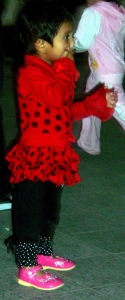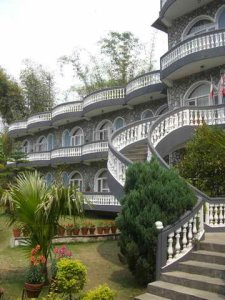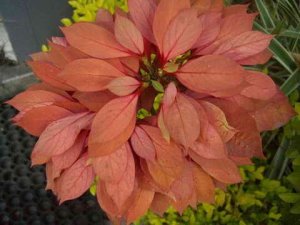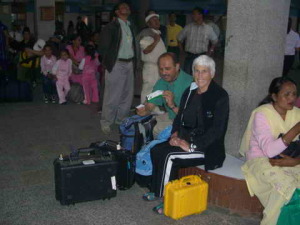Let me tell you about domestic flying in Nepal. All you feminists will not believe it. At the domestic airport when it’s time to pass through security, the women go on one side, the men on the other. It also happens when you depart through the gate for the bus that takes you to the plane. I felt like an Amish woman, or Moslem or Orthodox Jew. It’s a man’s world even here in Nepal. The good news was I could carry all the water I wanted through security.
The airplane from Kathmandu to Pokhara was one of the small putt-putts of Yati Airlines. I was squeezed into a single side seat with carry-ons sitting on my feet – there was no overhead bins. Just stuff it in front of you. The stewardess passed cotton balls for your ears and a caramel candy. It was only a thirty minute flight that didn’t get much higher than the hills around us. As we waited in the airport (who could understand the flight caller speaking in Nepalese and a v ersion of British English), I was intrigued even again by the well-dressed women. There’s a difference in the attire of a Nepali woman, a Sherpa woman, a Hindu woman, an Indian woman, and the Bhutan woman. Nepali women don’t wear saris, but a very short fitted top of a bright color, and a wrap around silk skirt with a long long tail that becomes a scarf tossed over the left shoulder. If there is gold in its pattern, that implies wealth. A wealthy woman might wear arrings so heavy with gold that she has to wear a support on her ears so they won’t rip off. Another woman wore a gold ring in her nose. But Sherpa women wear a modest long cotton printed dress with a contrasting striped apron, often quilted.
ersion of British English), I was intrigued even again by the well-dressed women. There’s a difference in the attire of a Nepali woman, a Sherpa woman, a Hindu woman, an Indian woman, and the Bhutan woman. Nepali women don’t wear saris, but a very short fitted top of a bright color, and a wrap around silk skirt with a long long tail that becomes a scarf tossed over the left shoulder. If there is gold in its pattern, that implies wealth. A wealthy woman might wear arrings so heavy with gold that she has to wear a support on her ears so they won’t rip off. Another woman wore a gold ring in her nose. But Sherpa women wear a modest long cotton printed dress with a contrasting striped apron, often quilted.
 ersion of British English), I was intrigued even again by the well-dressed women. There’s a difference in the attire of a Nepali woman, a Sherpa woman, a Hindu woman, an Indian woman, and the Bhutan woman. Nepali women don’t wear saris, but a very short fitted top of a bright color, and a wrap around silk skirt with a long long tail that becomes a scarf tossed over the left shoulder. If there is gold in its pattern, that implies wealth. A wealthy woman might wear arrings so heavy with gold that she has to wear a support on her ears so they won’t rip off. Another woman wore a gold ring in her nose. But Sherpa women wear a modest long cotton printed dress with a contrasting striped apron, often quilted.
ersion of British English), I was intrigued even again by the well-dressed women. There’s a difference in the attire of a Nepali woman, a Sherpa woman, a Hindu woman, an Indian woman, and the Bhutan woman. Nepali women don’t wear saris, but a very short fitted top of a bright color, and a wrap around silk skirt with a long long tail that becomes a scarf tossed over the left shoulder. If there is gold in its pattern, that implies wealth. A wealthy woman might wear arrings so heavy with gold that she has to wear a support on her ears so they won’t rip off. Another woman wore a gold ring in her nose. But Sherpa women wear a modest long cotton printed dress with a contrasting striped apron, often quilted. We have pared down our multiple bags to just two with two backpacks and Jim’s two equipment boxes. These will be toted by Sherpas, who met us in the garden at our charming overnight stop, Hotel Kantipur, resembling a Nepali version of a Swiss chalet, four blue gray stories high with white balconies and gingerbread trim. It’s not a luxury hotel but a rest stop for trekkers. Inside the door of my room sit cardboard pleas not to wash your clothes, do drink the water purified by Euroguard, a friendly machine, it reads; pull off the TV cable if there is lightening, and do not leave lights or anything electrica l running when you leave the room. There is an air condition unit not needed this night. It’s hot in this lower valley of Nepal, but through the grace of Mother Nature, a cool breeze has blown up with a bowls of raindrops and ominous thunder. The garden has been well tended with many plants in pots, a well trimmed hedge and shaped shrubs. They put the flowering petunias and roses in pots under a shelter when the rain comes, so petals won’t fall..
l running when you leave the room. There is an air condition unit not needed this night. It’s hot in this lower valley of Nepal, but through the grace of Mother Nature, a cool breeze has blown up with a bowls of raindrops and ominous thunder. The garden has been well tended with many plants in pots, a well trimmed hedge and shaped shrubs. They put the flowering petunias and roses in pots under a shelter when the rain comes, so petals won’t fall..
We are prepared to start the Annapurna Trek at seven in the morning. We will be in the land of the Gurung, the tough, disciplined tribe of men who to this day are recruited by the British to form their Ghurka soldiers that made names for themselves during the World Wars. The British were never able to conquer Nepal. The Gurungs were too ferocious and could defend the hills and mountains from the very peaks protecting Nepal from invaders. The British gave up and were so impressed with the Gurungs that they hired them to fight their own battles in the wars. The Ghurkas became heroes.
 l running when you leave the room. There is an air condition unit not needed this night. It’s hot in this lower valley of Nepal, but through the grace of Mother Nature, a cool breeze has blown up with a bowls of raindrops and ominous thunder. The garden has been well tended with many plants in pots, a well trimmed hedge and shaped shrubs. They put the flowering petunias and roses in pots under a shelter when the rain comes, so petals won’t fall..
l running when you leave the room. There is an air condition unit not needed this night. It’s hot in this lower valley of Nepal, but through the grace of Mother Nature, a cool breeze has blown up with a bowls of raindrops and ominous thunder. The garden has been well tended with many plants in pots, a well trimmed hedge and shaped shrubs. They put the flowering petunias and roses in pots under a shelter when the rain comes, so petals won’t fall..We are prepared to start the Annapurna Trek at seven in the morning. We will be in the land of the Gurung, the tough, disciplined tribe of men who to this day are recruited by the British to form their Ghurka soldiers that made names for themselves during the World Wars. The British were never able to conquer Nepal. The Gurungs were too ferocious and could defend the hills and mountains from the very peaks protecting Nepal from invaders. The British gave up and were so impressed with the Gurungs that they hired them to fight their own battles in the wars. The Ghurkas became heroes.
Our three sherpas met with us after a lunch of fascinating Nepali-Indian dishes: Paratha which is a flat bread folded and filled with vegetables, and Paneer Butter Masala, which is a curry made wit h white farmers cheese. As we ate, Jim gave a run through of the history of China-Tibet relations; British, India, Tibet and China relations when Mao and Nehru, normally enemies, silently agreed to permit so many Hindu pilgrims to visit the sacred mountain of Mt. Kailash each year. Jim also told of the many adventurers who have braved the conditions here since 1929 when Shipman and Tillman after walking to Mt. Everest from Calcutta, discovered the Kumbu Icefall as they hunted for a way to make it up the giant wall that is Mt. Everest. These men returned to England and lobbied for an expedition to attempt the Everest climb. In 1929 Mallory and Irvine won the call and were the first to probably reach the summit of Everest but they disappeared leaving no evidence of their summit success, until ten years ago the body of Mallory was found near the top. Of course Everest gets all the attention, but the second highest mountain in the world, called K-2 by surveyors, is a serious challenge for the most advanced of climbers, and rarely reached. It’s in the Karakoran range of mountains which parallel
h white farmers cheese. As we ate, Jim gave a run through of the history of China-Tibet relations; British, India, Tibet and China relations when Mao and Nehru, normally enemies, silently agreed to permit so many Hindu pilgrims to visit the sacred mountain of Mt. Kailash each year. Jim also told of the many adventurers who have braved the conditions here since 1929 when Shipman and Tillman after walking to Mt. Everest from Calcutta, discovered the Kumbu Icefall as they hunted for a way to make it up the giant wall that is Mt. Everest. These men returned to England and lobbied for an expedition to attempt the Everest climb. In 1929 Mallory and Irvine won the call and were the first to probably reach the summit of Everest but they disappeared leaving no evidence of their summit success, until ten years ago the body of Mallory was found near the top. Of course Everest gets all the attention, but the second highest mountain in the world, called K-2 by surveyors, is a serious challenge for the most advanced of climbers, and rarely reached. It’s in the Karakoran range of mountains which parallel s the Himalayas.
s the Himalayas.
 h white farmers cheese. As we ate, Jim gave a run through of the history of China-Tibet relations; British, India, Tibet and China relations when Mao and Nehru, normally enemies, silently agreed to permit so many Hindu pilgrims to visit the sacred mountain of Mt. Kailash each year. Jim also told of the many adventurers who have braved the conditions here since 1929 when Shipman and Tillman after walking to Mt. Everest from Calcutta, discovered the Kumbu Icefall as they hunted for a way to make it up the giant wall that is Mt. Everest. These men returned to England and lobbied for an expedition to attempt the Everest climb. In 1929 Mallory and Irvine won the call and were the first to probably reach the summit of Everest but they disappeared leaving no evidence of their summit success, until ten years ago the body of Mallory was found near the top. Of course Everest gets all the attention, but the second highest mountain in the world, called K-2 by surveyors, is a serious challenge for the most advanced of climbers, and rarely reached. It’s in the Karakoran range of mountains which parallel
h white farmers cheese. As we ate, Jim gave a run through of the history of China-Tibet relations; British, India, Tibet and China relations when Mao and Nehru, normally enemies, silently agreed to permit so many Hindu pilgrims to visit the sacred mountain of Mt. Kailash each year. Jim also told of the many adventurers who have braved the conditions here since 1929 when Shipman and Tillman after walking to Mt. Everest from Calcutta, discovered the Kumbu Icefall as they hunted for a way to make it up the giant wall that is Mt. Everest. These men returned to England and lobbied for an expedition to attempt the Everest climb. In 1929 Mallory and Irvine won the call and were the first to probably reach the summit of Everest but they disappeared leaving no evidence of their summit success, until ten years ago the body of Mallory was found near the top. Of course Everest gets all the attention, but the second highest mountain in the world, called K-2 by surveyors, is a serious challenge for the most advanced of climbers, and rarely reached. It’s in the Karakoran range of mountains which parallel s the Himalayas.
s the Himalayas.There are a million stories and both Jim and I were inspired to be adventurers, though with different capacities of a sort, by the writings of Memphian Richard Halliburton. Jim when young was given books by his mother about explorer Sir Richard Burton who in the 1840s studied religious practices of Asia, translated the Karma Sutra and 101 Arabian Nights, was the first non-Arab to go to Mecca, searched for the source of the Nile, studied the Mormons for two years in the US, and finally died as a British consul in Brazil. Jim will tell you that I’m not a mountain climber (true) but in order to see the things that fascinate me, I must become a trekker and partial climber to get there. Jim has spent his life exploring, climbing and discovering, being a member of the first group to ski to the South Pole, and climbing all seven summits in one year. (Seven sum mits are the highest peaks on the seven continents.)
mits are the highest peaks on the seven continents.)
 mits are the highest peaks on the seven continents.)
mits are the highest peaks on the seven continents.) We are both sad that Mt. Kailash has been put off limits by China for the coming months, but a new itinerary and adventure is in the midst of preparation for the two weeks we had hoped to circumnavigate the holy mountain as pilgrims. At this moment, thunder is playing its base drum. Rain will clean the air. The garden is filled with trekkers, sherpas, and tired feet. The bed in my room is harder than a rock (makes me think of those platforms bearing the dead of war the Indians and Arabs haul through streets as mobs rave and rant), but it’s a bed. We are blessed. Namaste.
Photos: Sitting in airport with travel agent Jiban; Typical Nepli dress; Other dress styles; A child to watch; Hotel Kantipur; Lalupati.

